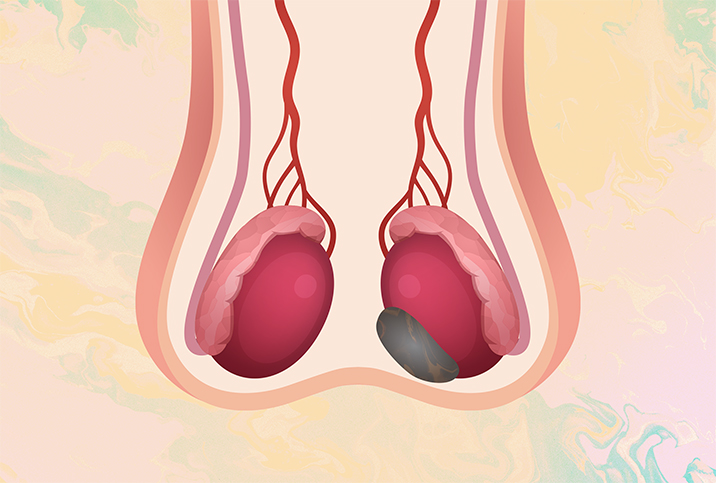Watch Out for These Very Rare Symptoms of Testicular Cancer

It's easy to think it will never happen to you. About 1 in every 250 men develop testicular cancer.
But young men in particular should be on the lookout for this disease.
"Although it can occur at any age, testicular cancer is most common in younger men between the late teenage years to age 35," said Rodwell Mabaera, M.D., Ph.D., a medical oncologist and testicular cancer specialist at Dartmouth Cancer Center in Lebanon, New Hampshire.
No matter your age, it's essential to stay alert for concerning symptoms of testicular cancer. As is the case with most cancers, early detection can profoundly impact your chance of recovery and survival.
Of course, detection requires knowledge of those signs, even the rare symptoms of testicular cancer.
The most common sign of testicular cancer
Fortunately, the most common indication of testicular cancer is also easy to spot. We're talking about a painless lump on the testicle itself.
Sometimes, rather than a single lump, you'll notice a generally swollen or enlarged testicle. Being familiar with your body is vital, because it's normal for one testicle to be a bit larger than the other. Regular self-exams help you get a feel for what's normal and improve your odds of early detection.
3 rare symptoms of testicular cancer
Testicular lumps and swollen testicles are the most frequently reported symptoms of the disease. This form of cancer, however, sometimes triggers symptoms in other parts of your body.
If you're experiencing one of these rarer signs of testicular cancer, remember that the symptom could—and most likely does—point to something less dire. Still, make an appointment with a medical professional. They can give you a physical exam, make a diagnosis and start looking at treatment options.
Changing breast tissue tenderness
"Testicular cancer is a rare cause of breast tissue growth," said Alok Tewari, M.D., Ph.D., a medical oncologist and genitourinary cancer expert at Dana-Farber Cancer Institute in Boston. He said the disease accounts for approximately 3 percent of abnormal breast tissue enlargement cases.
"This happens because some testicular cancers produce the pregnancy hormone called human chorionic gonadotropin, which is responsible for the breast changes," Mabaera explained.
Breast tissue enlargement can also occur in a rarer type of testicular cancer called Leydig cell tumors.
While certain testicular tumors can trigger breast development, cancer isn't the only culprit behind male breast tissue changes.
Some other possible contributors to breast enlargement include:
- Certain medications or controlled substances
- Liver disease
- Malnourishment
- Thyroid issues
Make an appointment to see a medical professional if you notice swelling or pain around your nipples, especially if the changes involve both sides, according to Mabaera.
Leg swelling
As the name suggests, testicular cancer develops in one of your testicles. But you might notice symptoms in other places if the cancer has spread beyond your genitals.
"Swelling in the legs can be a sign that testicular cancer has spread to lymph nodes in the pelvis and abdomen," Mabaera said. "Leg swelling happens as a result of enlarged lymph nodes in the abdomen or pelvis blocking blood and lymphatic flow from the legs."
Leg swelling isn't always caused by testicular cancer, but Mabaera said it's almost always serious as other potential culprits include heart failure and blood clots. So if you notice one or both legs have unexplained swelling, you should be evaluated by a doctor.
Unexplained back pain
First things first: A sore back is very rarely a sign of testicular cancer.
"Back pain is very common, especially for people who sit for long periods," Tewari said. "Testicular cancer is not very common, and so unexplained back pain is unlikely to represent testicular cancer that has spread."
Still, testicular cancer that has spread into the pelvis or abdomen can cause back pain which slowly worsens and doesn't improve with usual treatments.
So what's the difference between back pain caused by testicular cancer and run-of-the-mill back pain?
"Some clues are back pain in an otherwise healthy young man, pain that includes the perineal area or scrotum/groin, or pain that does not seem to have an obvious location," Mabaera said.
People with testicular cancer-related back pain might feel that something else is "off," such as a lack of appetite, unexplained weight loss or pain that feels deeper than typical muscular pain, according to Tewari.
So while back pain alone rarely indicates testicular cancer, the possibility still exists. Talk to your doctor if you have unexplained back pain that doesn't seem to get better with rest, stretching or muscle relaxers. As with most types of cancer or musculoskeletal issues, early intervention can help.
Know your risk
Testicular cancer is most common among younger men, who commonly put off medical checkups. The disease has a remarkable 99 percent five-year relative survival rate if early detection finds the cancer has not spread outside of the testicles.
Of course, there are testicular cancer risk factors beyond age. A family history of the disease is an obvious one. Men with HIV are at higher risk. Any condition that affects testicular development—Klinefelter syndrome for example, according to Mabaera—can increase your risk.
White men also have a higher risk of testicular cancer than men who identify as another race, according to Tewari. Both doctors said men with a history of cryptorchidism—an undescended testicle—have a higher risk of developing testicular cancer. That's true even after surgical intervention.
The bottom line: Know your risk and know the signs. Talk to your doctor if you notice any symptoms of testicular cancer. It doesn't matter if it's the common testicular lump or the very rare signs discussed here.


















